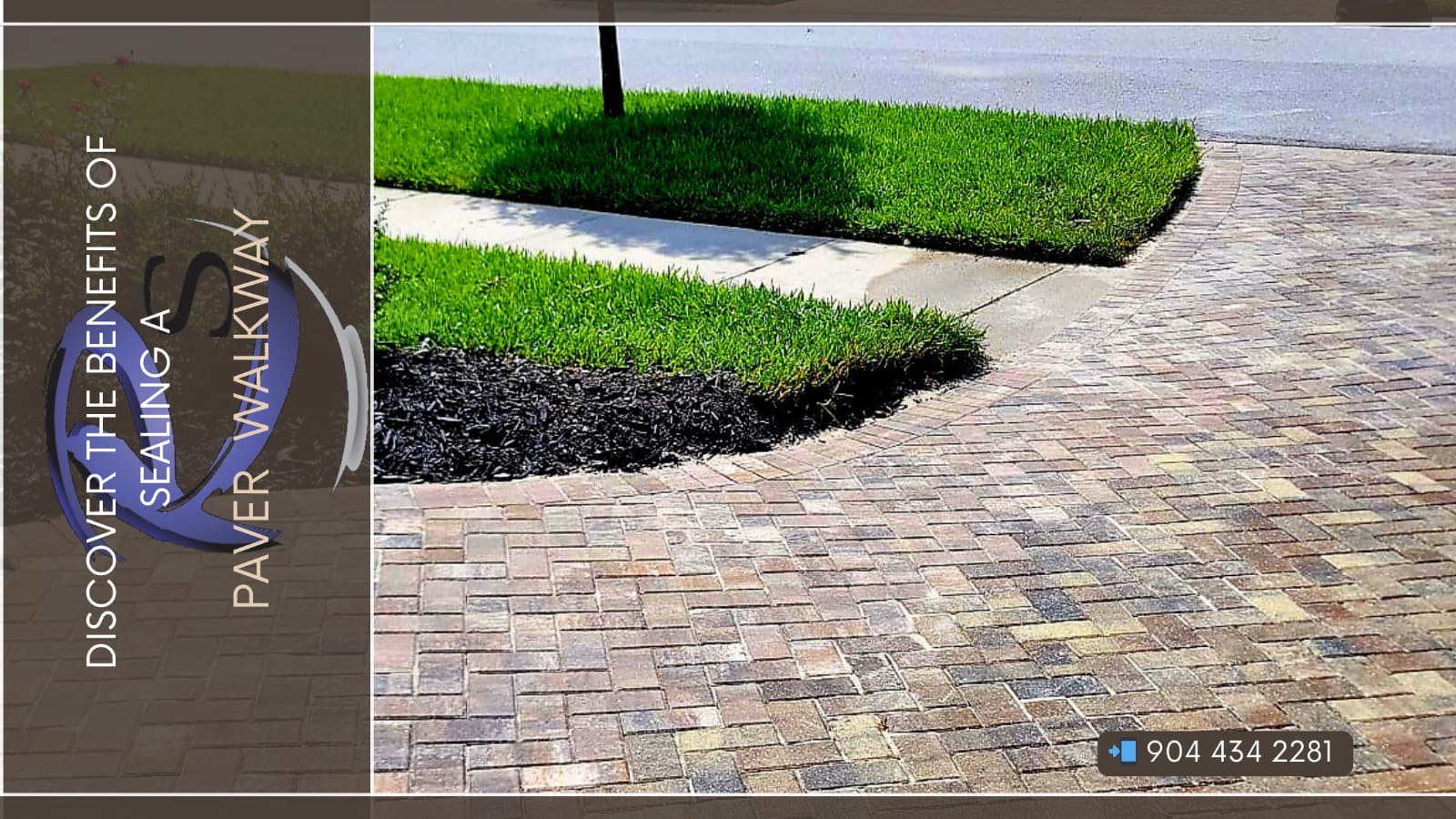Whether you have a paver walkway in your backyard or at the entrance of your business, sealing it can provide numerous benefits. Sealing a paver walkway is a protective measure that can enhance its durability, improve its aesthetic appeal, and reduce maintenance needs. However, it is important to consider the trade-offs involved and be aware of the challenges associated with different sealing approaches.
Durability
One of the primary benefits of sealing a paver walkway is enhancing its durability. Sealing creates a protective barrier on the surface of the pavers, preventing water penetration, weed growth, and damage caused by freeze-thaw cycles. A sealed walkway is less prone to cracking, shifting, and fading over time.
Aesthetics
Sealing a paver walkway can also significantly improve its aesthetic appeal. The sealer can deepen the color of the pavers, enhancing their natural beauty. It can also provide a glossy or matte finish, depending on your preference. Additionally, the sealer can protect the pavers from stains caused by spills, oil, or mildew, keeping them looking clean and vibrant for longer periods.
Maintenance
Sealed paver walkways require less maintenance compared to unsealed ones. The sealer acts as a barrier against dirt, dust, and other debris, making it easier to clean and maintain the pavers. Regular sweeping or rinsing will usually suffice to keep the walkway in good condition. Additionally, the sealer can make it easier to remove stains and prevent the growth of moss or algae, reducing the need for intensive cleaning.
Trade-Offs and Challenges
While there are clear benefits to sealing a paver walkway, it is important to consider the trade-offs involved. Firstly, sealing can make the surface slightly slippery when wet, which may pose a safety concern. However, there are anti-slip sealers available that can mitigate this issue. It is also crucial to ensure that the pavers are correctly installed and in good condition before sealing, as any existing damage or issues may worsen over time if not addressed first.
Another challenge is that sealed paver walkways may require periodic resealing, typically every 2-3 years. The frequency may vary depending on factors such as climate, foot traffic, and the quality of the sealer used. Resealing involves cleaning the walkway, removing the old sealer, and applying a fresh coat. It is essential to follow the manufacturer’s instructions and use the appropriate sealer to maintain the effectiveness of the protection.
Cost
The cost of sealing a paver walkway is an important factor to consider. Sealing products vary in price, and the total cost will depend on the size of the walkway and the desired quality of the sealer. However, it is important to note that sealing can potentially save you money in the long run by extending the lifespan of your pavers and reducing the need for repairs or replacement.
Environmental Impact
When considering the benefits of sealing a paver walkway, it is important to also consider the environmental impact. Some sealers contain chemicals that can be harmful to the environment, especially if they leach into the soil or water sources. It is recommended to choose a sealer that is specifically formulated to be environmentally friendly or water-based. These types of sealers have a reduced impact on the ecosystem.
Application Process
The process of sealing a paver walkway can be a DIY project or may require the assistance of a professional. The application process typically involves cleaning the pavers thoroughly, allowing them to dry, and then applying the sealer according to the manufacturer’s instructions. It is essential to follow the correct application techniques to ensure an even and effective coat of sealer. If you are unsure or have a large area to seal, it may be best to hire a professional to ensure optimal results.
Choosing the Right Sealer
There are various types of sealers available on the market, including penetrating sealers, film-forming sealers, and color-enhancing sealers. Each type has its own advantages and considerations. For instance, penetrating sealers offer excellent protection while maintaining the natural look of the pavers, while film-forming sealers create a protective coating on the surface. Researching and consulting with professionals can help you choose the right sealer that best meets your needs.
Impact on Joint Stability
Sealing a paver walkway can have an impact on the stability of the joints between the pavers. Some sealers can harden the sand or jointing material, reducing its flexibility and increasing the risk of cracking or shifting. It is important to consider this factor when selecting a sealer and to ensure proper joint stabilization methods are employed to maintain the integrity of the walkway.
UV Protection
UV rays from the sun can cause fading and discoloration of pavers over time. Sealing a paver walkway can provide protection against UV damage, helping to preserve the color and vibrancy of the pavers. Look for a sealer that offers UV protection to maintain the aesthetic appeal of your walkway.
Preventing Weed Growth
Unsealed paver walkways are susceptible to weed growth between the joints. Sealing the walkway can help prevent weed growth by creating a barrier that inhibits weed seeds from taking root and thriving. This can save you time and effort in removing weeds and maintaining the pristine appearance of your walkway.
Longevity of the Pavers
A sealed paver walkway is likely to have a longer lifespan compared to an unsealed one. By protecting the pavers from environmental factors, such as moisture and freeze-thaw cycles, sealing can prevent damage, cracking, and erosion, thereby extending the overall durability of the walkway.
Enhanced Curb Appeal
Sealing a paver walkway can greatly enhance the curb appeal of your property. A well-maintained and visually appealing walkway can make a positive impression on visitors or potential buyers. The glossy or matte finish achieved through sealing adds an extra touch of elegance and sophistication to your outdoor space.
Reduced Effort in Removing Stains
Sealing a paver walkway makes it easier to clean and remove stains. The protective layer created by the sealer prevents stains from penetrating the surface of the pavers, allowing for easier removal of spills, oil stains, or other pollutants. Regular maintenance and cleaning can be done with minimal effort, ensuring that your walkway remains spotless and attractive.
Improving Safety in Freezing Conditions
In regions with freezing temperatures, unsealed paver walkways can become hazardous as water seeps into the pavers, freezes, and creates slippery ice patches. Sealing the walkway helps to prevent water infiltration, reducing the risk of slip-and-fall accidents during freezing conditions.
Preserving the Sand Joints
The sand joints between the pavers play a crucial role in maintaining the stability and structural integrity of the walkway. Sealing the pavers can help preserve the sand joints by preventing erosion, weed growth, and the infiltration of debris. This ensures that the walkway remains structurally sound and level over time.
Increasing Property Value
A well-maintained and visually appealing paver walkway can significantly increase the value of your property. Potential buyers are often drawn to attractive and functional outdoor spaces, and a sealed walkway can be a selling point that sets your property apart from others in the market.
Check other article – paver walkway
- The wonders of a paved backyard
- Add the perfect accent with driveway pavers Jacksonville
- Pavers walkway sealer can enhance colors
- Unearth The Beauty Of Paver Walkways
Regular Maintenance and Inspection
Even with sealing, regular maintenance and inspection of your paver walkway are still necessary. Periodic cleaning, resealing as needed, and addressing any issues, such as cracked or shifted pavers, will help ensure the longevity and optimal performance of your walkway.
Conclusion – paver walkway
Sealing a paver walkway offers several benefits such as improved durability, enhanced aesthetics, and reduced maintenance needs. However, it is crucial to consider the trade-offs and challenges involved, such as potential slipperiness, periodic resealing, and the environmental impact of the sealer. By weighing these factors and making informed decisions, you can enjoy a beautiful, long-lasting, and well-maintained paver walkway.

